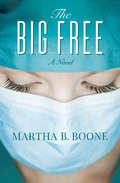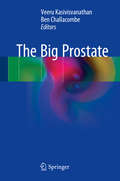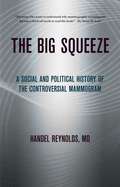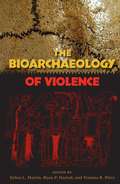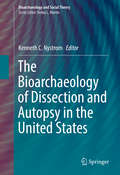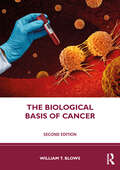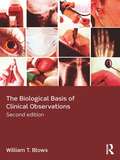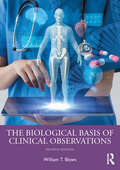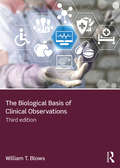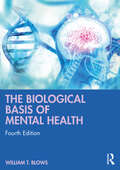- Table View
- List View
The Big Free: A Novel
by Martha B. BooneA young female doctor faces the violence, debauchery, and larger-than-life characters of a New Orleans surgery in this funny and gritty medical novel. New Orleans, 1982. Voodoo spells, prostitutes, prisoners, and veterans who are adamant about the size of their manhood—it&’s all just another day at Charity Hospital, also known as The Big Free. It&’s a medical free-for-all with the toughest trauma surgery in America, and Elizabeth—fresh from medical school in Charleston, wearing pearls and pink plaid socks—is one of the first women to work there. Half of the doctors who start the surgery program never finish. Nothing in her proper Southern upbringing prepared Elizabeth for the gritty and gruesome world she now experiences on a daily basis. And even if she&’s tougher than anyone first expected, the question remains . . . will she make the cut? Full of drama, humor, and New Orleans flavor, The Big Free is a young doctor&’s coming of age story as only a true medical insider can tell it.
The Big Necessity: The Unmentionable World of Human Waste and Why It Matters
by Rose GeorgeDelving deep into the history and implications of a daily act that dare not speak its name, The Big Necessity is on its way to removing the taboo on bodily waste something common to all and as natural as breathing.
The Big Necessity: The Unmentionable World of Human Waste and Why It Matters
by Rose GeorgeAn “extraordinary” look at the stubborn problem of human waste disposal: “Among the best nonfiction books of the new millennium.” —The New York TimesAcclaimed as “valuable and often entertaining” (Los Angeles Times), The Big Necessity defies the taboo on bodily waste—something common to all and as natural as breathing. We prefer not to talk about it, but we should—even those of us who take care of our business in pristine, sanitary conditions. Disease spread by waste kills more people worldwide every year than any other single cause of death. Even in America, nearly two million people have no access to an indoor toilet. Yet the subject remains unmentionable.Moving from the underground sewers of Paris, London, and New York (an infrastructure disaster waiting to happen) to an Indian slum where ten toilets are shared by 60,000 people, The Big Necessity breaks the silence, revealing everything that matters about how people do—and don’t—deal with their own waste. With razor-sharp wit and crusading urgency, mixing levity with gravity, Rose George has turned the subject we like to avoid into a cause with the most serious of consequences.“One smart book . . . delving deep into the history and implications of a daily act that dare not speak its name.” —Newsweek“Makes a passionate argument for putting sanitation at the top of the world’s development agenda.” —Time“With irreverence and pungent detail, George breaks the embarrassed silence over the economic, political, social and environmental problems of human waste disposal. Full of fascinating facts . . . an intrepid, erudite and entertaining journey through the public consequences of this most private behavior.” —Publishers Weekly (starred review)
The Big One: How We Must Prepare for Future Deadly Pandemics
by Mark Olshaker Michael T. OsterholmAs bad as Covid-19 was, the next pandemic could be worse—but we have the tools to prepare, as revealed in this urgent, gripping warning by the New York Times bestselling authors of Deadliest Enemy. The Covid-19 pandemic was the most devastating natural event of the last century, killing more than 7 million people around the globe, straining the fabric of societies internationally, and shaking the foundations of the global economy. And yet, as horrifying as the experience was, Covid-19 was not actually &“the Big One&” — the dreaded potential pandemic that haunts the nightmares of epidemiologists and public health officials everywhere, and which will alter life across the world on every meaningful level unless we are ready to deal with it. Indeed, even as we learn to live with Covid-19 and continue to recover from its worst effects, the next pandemic is already lurking around the corner—and it may very well be worse. In The Big One, founding director of the Center for Infectious Disease Research and Policy Michael T. Osterholm and Mark Olshaker examine past pandemics, highlighting the ways societies both succeeded and failed to address them; trace the Covid-19 pandemic and evaluate how it was handled; and look to the future, projecting what the next pandemics might look like and what must be done to mitigate them. Drawing on years of high-level research as well as cutting-edge analysis and an innovative hypothetical scenario threaded throughout each chapter, The Big One is a gripping, comprehensive, and urgent wake-up call. Because Covid-19 was just a taste of what&’s to come. If we&’re going to survive the next big pandemic, we need to be prepared.
The Big Prostate
by Ben Challacombe Veeru KasivisvanathanThis book will explore and explain the best diagnostic and treatment strategies for men with a big prostate. Men are living longer and the opportunity to develop significant benign prostatic hyperplasia is increasing. Men with very large prostates can often be extremely challenging to manage and all urologists and healthcare professionals carrying out general urology and managing men with prostate problems will have come across this issue. There are a number of diagnostic, interventional, and surgical management options available, with some of these being more suited to a large prostate than others. The various treatment strategies and their evidence base are discussed. Valuable tips from expert authors who are experienced in the management of the particularly large prostate are included to allow readers to be confident when managing this increasingly important and prevalent group of patients. This book is of particular use to healthcare practitioners who manage men with BPH in the outpatient or emergency setting, as well as those in the operating theatre who want further tips on how to deal with the particularly big prostate.
The Big Squeeze
by Handel ReynoldsIn 2009, an influential panel of medical experts ignited a controversy when they recommended that most women should not begin routine mammograms to screen for breast cancer until the age of fifty, reversing guidelines they had issued just seven years before when they recommended forty as the optimal age to start getting mammograms. While some praised the new recommendation as sensible given the smaller benefit women under fifty derive from mammography, many women's groups, health care advocates, and individual women saw the guidelines as privileging financial considerations over women's health and a setback to decades-long efforts to reduce the mortality rate of breast cancer. In The Big Squeeze, Dr. Handel Reynolds, a practicing radiologist, notes that this episode was only the most recent controversy in the turbulent history of mammography since its introduction in the early 1970s. In a book written for the millions of women who face the decision about whether to get a mammogram, health professionals interested in cancer screening, and public health policymakers, Reynolds shows how pivotal decisions made during mammography's initial launch made it all but inevitable that the test would be contentious. He describes how, at several key points in its history, the emphasis on mammography screening as a fundamental aspect of women's preventive health care coincided with social and political developments, from the women's movement in the early 1970s to breast cancer activism in the 1980s and '90s. At the same time, aggressive promotion of mammography made the screening tool the cornerstone of a huge new industry. Taking a balanced approach to this much-disputed issue, Reynolds addresses both the benefits and risks of mammography, charting debates, for example, that have weighed the early detection of aggressively malignant tumors against unnecessary treatments resulting from the identification of slow-growing and non-life-threatening cancers. The Big Squeeze, ultimately, helps to evaluate the ongoing public health controversies surrounding mammography and provides a clear understanding of how mammography achieved its current primacy in cancer screening.
The Bigger Fish: Two Girls, One Guy, Some Choices
by Roets MagdelTwo girls, one man, drugs, and salvation. They all have to choose, and when they do, their choice have to be from a sincere and undivided heart.
The Billionaire Murders: The Mysterious Deaths of Barry and Honey Sherman
by Kevin DonovanA top journalist crosses the yellow tape to investigate a shocking high-society crime.Billionaires, philanthropists, socialites . . . victims. Barry and Honey Sherman appeared to lead charmed lives. But the world was shocked in late 2017 when their bodies were found in a bizarre tableau in their elegant Toronto home. First described as murder-suicide — belts looped around their necks, they were found seated beside their basement swimming pool — police later ruled it a staged, targeted double murder. Nothing about the case made sense to friends of the founder of one of the world’s largest generic pharmaceutical firms and his wife, a powerhouse in Canada’s charity world. Together, their wealth has been estimated at well over $4.7 billion. There was another side to the story. A strategic genius who built a large generic drug company — Apotex Inc. — Barry Sherman was a self-described workaholic, renowned risk-taker, and disruptor during his fifty-year career. Regarded as a generous friend by many, Sherman was also feared by others. He was criticized for stifling academic freedom and using the courts to win at all costs. Upset with building issues at his mansion, he sued and recouped millions from tradespeople. At the time of his death, Sherman had just won a decades-old legal case involving four cousins who wanted 20 percent of his fortune. Toronto Star investigative journalist Kevin Donovan chronicles the unsettling story from the beginning, interviewing family members, friends, and colleagues, and sheds new light on the Shermans’ lives and the disturbing double murder. Deeply researched and authoritative, The Billionaire Murders is a compulsively readable tale of a strange and perplexing crime.
The Billionaire's Christmas Wish (Hope Children's Hospital #4)
by Tina BeckettOnly a Christmas miracle…Will make his wish come true.In this Hope Children’s Hospital story, since losing his wife Theo Hawkwood hasn’t enjoyed Christmas, and now his daughter Ivy is ill, he has even less reason to celebrate. Unless visiting diagnostician, Madison Archer, can perform a miracle… While Madison works to find a cure, Theo is fighting a growing attraction to her… Is Madison the miracle he’s been waiting for?Hope Children’s Hospital miniseries Book 1 — Their Newborn Baby Gift by Alison RobertsBook 2 — One Night, One Unexpected Miracle by Caroline AndersonBook 3 — The Army Doc’s Christmas Angel by Annie O’NeilBook 4 — The Billionaire’s Christmas Wish by Tine Beckett “Really everything about this story was captivating from the wonderful main characters to the riveting dialogue to the fast-paced and entertaining plot.” Harlequin Junkie on Tempted by Dr. Patera “This was a highly emotional but entertaining read that had me smiling and almost in tears at various times throughout….” —Harlequin Junkie on The Doctors’ Baby Miracle
The Bioarchaeology Of Violence (Bioarchaeological Interpretations Of The Human Past: Local, Regional, And Global Ser.)
by Debra Martin Ryan Harrod Ventura Pérez"The tragedies of violence have seldom been told with such a compelling use of the biocultural perspective. Building on a solid methodological foundation, we are served theoretical perspectives that are unusually rich and nuanced in their application to the case studies. This collection of case studies is a valuable contribution to the bioarchaeological literature."--George Armelagos, Emory University Human violence is an inescapable aspect of our society and culture. As the archaeological record clearly shows, this has always been true. What is its origin? What role does it play in shaping our behavior? How do ritual acts and cultural sanctions make violence acceptable? These and other questions are addressed by the contributors to The Bioarchaeology of Violence. Organized thematically, the volume opens by laying the groundwork for new theoretical approaches that move beyond interpretation; it then examines case studies from small-scale conflict to warfare to ritualized violence. Experts on a wide range of ancient societies highlight the meaning and motivation of past uses of violence, revealing how violence often plays an important role in maintaining and suppressing the challenges to the status quo, and how it is frequently a performance meant to be witnessed by others. The interesting and nuanced insights offered in this volume explore both the costs and the benefits of violence throughout human prehistory.
The Bioarchaeology of Dissection and Autopsy in the United States (Bioarchaeology and Social Theory)
by Kenneth C. NystromEncountering evidence of postmortem examinations- dissection or autopsy in historic skeletal collections is relativelyrare, but recently there has been an increase in the number of reportedinstances. And much of what has been evaluated has been largely descriptiveand historical. The Bioarchaeology ofDissection and Autopsy brings together in a single volume the skeletal evidence ofpostmortem examination in the United States. Ranging from the earlycolonial period to the early 1900's, from a coffeehouse at ColonialWilliamsburg to a Quaker burial vault in lower Manhattan, the contributions to this volume demonstrate the interpretive significance of a historically andtheoretically contextualizedbioarchaeology. The authors employ a wide range of perspectives, demonstrating how bioarchaeological evidence can be used to address a widerange of themes including social identity and marginalization, racialization,the nature of the body and fragmentation, and the emergence of medical practiceand authority in the United States.
The Biochemistry of Retinoid Signaling III: Vitamin A and Retinoic Acid in Embryonic Development (Subcellular Biochemistry #95)
by Mary Ann Asson-Batres Cecile Rochette-EglyThis book covers subjects that have major impacts on society, such as the mechanism of maternal-fetal transfer of vitamin A, and the effects of alcohol on retinoic acid signaling and mammalian embryonic development. There has been an awareness of the importance of consuming vitamins throughout human history, but empirical studies of their physiological role and mode of action only began about 150 years ago. Since then, the biochemical nature of vitamin A and its active derivative, retinoic acid, have been identified and researchers around the globe have investigated retinoic acid’s physiological function in growth processes and in maintaining life Written by leading experts, this book discusses the latest findings and advances in retinoic acid research. It addresses topics such as the role of retinoic acid signaling in a multitude of processes, including limb, heart and respiratory system development, as well as its role in maintaining postnatal organ systems. This book is a valuable resource for scientists involved in vitamin A/retinoic acid research and readers interested in developmental biology.
The Biodynamics of the Immune System: Balancing the Energies of the Body with the Cosmos
by Michael J. SheaBiodynamic therapy practices for optimizing the immune system and healing the spiritual suffering at the root of many modern ailments• Examines the need to restore balance to the immune system through a deeper spiritual connection to the energies of the universe• Shares unique biodynamic protocols to balance the metabolism with the cosmos as well as optimize the immune system and the function of the vagus nerveDrawing on more than 45 years of practicing Eastern medicine, Michael J. Shea, Ph.D., presents a holistic guide to biodynamic manual therapy practices for optimizing the immune system and for healing the deep spiritual suffering of our contemporary world. Showing spiritual suffering to be the root of our modern epidemic of metabolic syndrome and other widespread health issues, the author explains how the pervasive degradation of the human body relates directly with the food we eat, the air we breathe, and our thoughts and emotions. He explains how the Five Element theory of Eastern medicine offers a method to reclaim the body by sensing each element in and around us as a single continuum. Focusing especially on &“the fluid body&” in biodynamic osteopathy and biodynamic craniosacral therapy, the author shows how inflamed components of the fluid body, such as the blood and lymphatic system, form the substrate of metabolic syndromes. He offers practices to visualize the health of the fluid body. He explains how, in order to enact the full benefits of the immune system, we need to nurture a deep sense of safety inside the body--a symbolic return to our embryonic and cosmic origins and a restoration of our sacred wholeness. Offering an extensive section of therapeutic applications, including both in-person and remote techniques, the author shares new and unique biodynamic protocols to balance the metabolism with the cosmos as well as optimize the immune system and the function of the vagus nerve. Enacting healing at the deepest spiritual level, Shea reveals how to create inner and outer balance to restore wholeness as it was at the time of the origin of the universe.
The Bioethics of Pain Management: Beyond Opioids (Routledge Annals of Bioethics)
by Daniel S. GoldbergIn this book, public health ethicist Daniel S. Goldberg sets out to characterize the subjective experience of pain and its undertreatment within the US medical establishment, and puts forward public policy recommendations for ameliorating the undertreatment of pain. The book begins from the position that the overwhelming focus on opioid analgesics as a means for improving the undertreatment of pain is flawed, and argues instead that dominant Western models of biomedicine and objectivity delegitimize subjective knowledge of the body and pain in the US. This general intolerance for the subjectivity of pain is part of a specific American culture of pain in which a variety of actors take part, including not only physicians and health care providers, but also pain sufferers, caregivers, and policymakers. Concentrating primarily on bioethics, history, and public policy, the book brings a truly interdisciplinary approach to an urgent practical ethical problem. Taking up the practical challenge, the book culminates in a series of policy recommendations that provide pathways for moral agents to move beyond contests over drug policy to policy arenas that, based on the evidence, hold more promise in their capacity to address the devastating and inequitable undertreatment of pain in the US.
The Biological Basis of Cancer
by William T. BlowsIntroducing the biology of neoplastic disorders, this accessible book looks at how cancer damages the body, and how the treatments work. Updated with the most recent research evidence, this unique text explains the basic biology of neoplastic disease; discusses the biology of the wide range of common cancers, now including neurological disorders; identifies and explains the biological causes of cancer, with a focus on genetics, hormones, and environmental factors; explains drug action in chemotherapy and analgesia; discusses the role of nutrition in neoplastic disorders and their treatment. Presenting the essential knowledge for working with cancer patients and their families, this textbook is an important read for those working in cancer care or undertaking study in this area.
The Biological Basis of Clinical Observations
by William T. BlowsAccurate clinical observations are key to good patient care and fundamental to clinical practice. A thorough understanding of the biological science underlying vital observations - such as taking the temperature or measuring the pulse - enables health professionals to make well-informed clinical decisions quickly and accurately. To be fully competent in these basic skills, there is a need to understand not only how and why procedures are performed, but also how results are affected, for example by variation in technique or the health status of the patient. This new edition integrates clear explanations of the techniques involved in these procedures with the biological knowledge which gives them meaning. For each topic, William T. Blows explains the pathological basis for variations in observed results, focusing on relevant anatomy and physiology, genetics and pharmacology and the basic principles of care. This helpful text gives health practitioners at all levels the understanding needed to: Perform clinical observations accurately Make accurate judgements about the patient's condition Make accurate decisions concerning patient care. In addition to all-new chapters on observations of nutrition; fluid balance and hydration; drug side effects and interactions; skin and pain, the text looks at: Temperature Cardiovascular observations Respiratory observations Urinary and bowel observations Neurological observations The Biological Basis of Clinical Observations is a unique text which integrates explanations of essential procedures with the biological knowledge that underpins practice. It is essential reading for all students preparing for clinical practice.
The Biological Basis of Clinical Observations
by William T. BlowsFully updated for its fourth edition, The Biological Basis of Clinical Observations provides readers with the understanding needed to perform clinical observations, make accurate judgements about the patient’s condition and make good decisions concerning patient care. This essential textbook supports safe and effective clinical practice by explaining the techniques involved in making clinical observations, alongside the biological knowledge which gives them meaning. For each topic, it explains the pathological basis for variations in observed results, focusing on relevant anatomy and physiology, genetics and pharmacology, and the basic principles of care. A greatly expanded chapter on pharmacology reflects the increased importance of this subject in the nursing curriculum. Topics discussed include: temperature cardiovascular observations respiratory observations urinary and bowel observations neurological observations • nutrition fluid balance skin pharmacology pregnancy. The Biological Basis of Clinical Observations is a unique text which integrates explanations of essential procedures with the biological knowledge that underpins practice. It is essential reading for all nursing and healthcare students preparing for clinical practice.
The Biological Basis of Clinical Observations: Clinical Observations
by William T. BlowsAccurate clinical observations are fundamental to competent and safe healthcare practice. The Biological Basis of Clinical Observations gives readers the understanding needed to perform clinical observations accurately, make accurate judgements about the patient’s condition and make accurate decisions concerning patient care. This useful textbook integrates clear explanations of the techniques involved in making clinical observations, alongside the biological knowledge which gives them meaning. For each topic, it explains the pathological basis for variations in observed results, focusing on relevant anatomy and physiology, genetics and pharmacology and the basic principles of care. In addition to a new chapter on blood tests, the text has been updated throughout. It now incorporates increased coverage of paediatrics, movement and the musculo-skeletal system, the lymphatic system, pregnancy, diabetes, homeostasis and infection, amongst other areas. Topics discussed include: temperature cardiovascular observations respiratory observations urinary and bowel observations neurological observations nutrition fluid balance skin drug side effects, interactions and allergies. The Biological Basis of Clinical Observations is a unique text which integrates explanations of essential procedures with the biological knowledge that underpins practice. It is essential reading for all nursing and health students preparing for clinical practice.
The Biological Basis of Mental Health
by William T. BlowsThis book explores the underlying biology associated with the pathology of mental health disorders and the related nervous system. Fully revised for this third edition, each chapter has been updated to include the latest research, ideas and concepts in each field, and includes a new chapter on sleep. Integrating up-to-date pharmacological and genetic knowledge with an understanding of environmental factors that impact on human biology, The Biological Basis of Mental Health covers topics including brain development, neural communication, neurotransmitters and receptors, hormones and behaviour, genetic disorders, pharmacology, drug abuse, anxiety, schizophrenia, depression, epilepsy, subcortical degenerative diseases of the brain, dementia, developmental disorders, and sleep. Accessible and engaging, this is an essential text for mental health students, practitioners and educators.
The Biological Basis of Mental Health: Mental Health
by William T. BlowsThis book explores the underlying biology and neuroscience associated with mental health and wellbeing. This fully revised fourth edition includes new chapters on behavioural science, and brain-gut and brain-gender connections, as well as expanded content on memory and genetics. Integrating up-to-date pharmacological and genetic research with an understanding of environmental factors that impact on human biology, The Biological Basis of Mental Health covers topics including brain development, neural communication, neurotransmitters and receptors, hormones and behaviour, genetic disorders, pharmacology, substance misuse, anxiety, schizophrenia, depression, epilepsy, subcortical degenerative diseases of the brain, dementia, developmental disorders and sleep. This unique textbook is an essential read for all healthcare students, practitioners and educators with an interest in mental health and neuroscience.
The Biological Basis of Nursing: Cancer
by William T. BlowsPresenting specialized biological information on what cancer is, this book looks at how it damages the body, and how cancer treatments work. Engaging, accessible and illustrated throughout, this unique text: explains the basic biology of cancer discusses the biology of the wide range of common cancers identifies and explains the biological causes of cancer explains drug action in chemotherapy and analgesia explains the link between diet and cancer, and how diet is important in cancer therapy discusses the biological basis of a range of nursing skills linked to cancer. Providing nurses with the essential knowledge required for working with cancer patients and their families, this book will enable them to work with current and new forms of cancer treatment.
The Biological Mind: How Brain, Body, and Environment Collaborate to Make Us Who We Are
by Alan JasanoffA pioneering neuroscientist argues that we are more than our brainsTo many, the brain is the seat of personal identity and autonomy. But the way we talk about the brain is often rooted more in mystical conceptions of the soul than in scientific fact. This blinds us to the physical realities of mental function. We ignore bodily influences on our psychology, from chemicals in the blood to bacteria in the gut, and overlook the ways that the environment affects our behavior, via factors varying from subconscious sights and sounds to the weather. As a result, we alternately overestimate our capacity for free will or equate brains to inorganic machines like computers. But a brain is neither a soul nor an electrical network: it is a bodily organ, and it cannot be separated from its surroundings. Our selves aren't just inside our heads--they're spread throughout our bodies and beyond. Only once we come to terms with this can we grasp the true nature of our humanity.
The Biological Role of Small Leucine-Rich Proteoglycans (SLRPs) in Matrix Homeostasis and Diseases
by Polly LamaThis book covers advanced and up-to-date analyses of the synthesis, fragmentation, and dysregulation of Small Leucine-Rich Proteoglycans (SLRPs) in some common matrix-related diseases. These SLRPs act as autonomous triggers of inflammation in conditions such as cancer, cartilage tissue degeneration, renal (kidney) diseases, as well as skin, tendon, musculoskeletal, and craniofacial tissues, responding to stress, injury, and impairment of normal function. Chapters describe the significance behind the formation of proteolytic molecular fragments of SLRPs and why they alter inflammatory cell-signaling pathways, acting as Damage-Associated Molecular Patterns (DAMPs), that can function as Pathogen-Associated Molecular Patterns (PAMPs) in the early, intermediate, and advanced stages of matrix dysregulation and diseases. It also discusses evidence-based therapeutic approaches useful for identifying molecular fragments as potential biomarkers of matrix degeneration, providing a thorough understanding on the regulatory role of SLRPs in matrix homeostasis and diseases. The book is supplemented with well-illustrated figures, tabulated analysis, and critical review questions for further investigations that identifies gap in current understanding. The book is relevant for experts in medical sciences specializing in cell, extracellular matrix-based tissue analysis, researchers, as well as students interested in investigating matrix-related changes during the pathological progression of diseases.
The Biology - Chemistry Interface: A Tribute To Koji Nakanishi
by Raymond CooperA tribute to the pioneering scientific work of Professor Koji Nakanishi, whose studies of natural products have effaced some of the conventional boundaries between biology and chemistry. It discusses an array of chromatographic separation methods and determination of structures on a microscale, analyzes bioassay-directed fractionation and other means of isolating biologically active compounds from plants and other sources, covers vital enzymes isolated from marine organisms such as algae, and more.
The Biology And Treatment Of Cancer
by Arthur B. Pardee et al.Offers a broad audience a concise presentation of the most up-to-date knowledge about the biology and treatment of cancer Full coverage of cancer prevention and control Clear, thorough discussion of current and possible future therapies Edited by two of the most eminent and widely recognized scholars of cancer research and therapeutics in the world, with contributions from top researchers and clinicians from across North America
